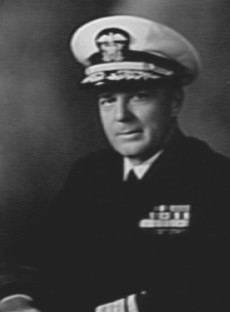Nickname(s) Tip Name Aaron Merrill | Years of service 1912–1947 | |
 | ||
Born March 26, 1890Brandon Hall, Washington, Mississippi ( 1890-03-26 ) Place of burial Natchez City Cemetery, Natchez (31°33′N 91°23′W / 31.550°N 91.383°W / 31.550; -91.383Coordinates: 31°33′N 91°23′W / 31.550°N 91.383°W / 31.550; -91.383) Commands held USS Harvard (SP-209)USS Elcano (PG-38)USS Williamson (DD-244)USS Pensacola (CA-24)Destroyer Division EightUSS Indiana (BB-58)Task Force 688th Naval DistrictGulf Sea Frontier People also search for Arleigh Burke, Matsuji Ijuin, Sentaro Omori | ||
Aaron Stanton Merrill (March 26, 1890 – February 28, 1961) also known as Tip Merrill was an American rear admiral during World War II who led American naval forces during the Solomon Islands campaign as well as the first admiral to solely use radar for fire control during wartime.
Contents
1912–1939
After graduating from the United States Naval Academy in 1912, Merrill first served for several years in the Mediterranean Sea. He was assigned to the destroyer Aylwin (DD-47), based in Plymouth, England, during the last months of World War I. In 1919 he commanded the patrol craft Harvard (SP-209), based at Harwich, England.
Merrill returned to the Mediterranean in late 1919 with the rank of lieutenant commander, to serve on the staff of Rear Admiral Mark Lambert Bristol, the United States High Commissioner to Turkey and Commander of United States Naval Forces in the Eastern Mediterranean. In 1925 he commanded the gunboat Elcano (PG-38) on the Yangtze Patrol.
After two years at the Office of Naval Intelligence in Washington, D.C., in June 1929 he was given command of the destroyer Williamson (DD-244). After three years at sea he was promoted to commander, and spent another year in the Office of Naval Intelligence, and then served as Aide to the Assistant Secretary of the Navy, Henry L. Roosevelt.
In June 1935 Merrill was assigned to the heavy cruiser Pensacola (CA-24), and received the Order of the Crown from the Belgian Government, after conveying the remains Paul May, the Belgian Ambassador to the United States, back to Antwerp.
From June 1936 he commanded Destroyer Division Eight, with Barry (DD-248) as flagship. He served for a year as Naval Attaché at the American Embassy at Santiago, Chile from May 1937. During his period he cruised extensively with the Chilean Navy, becoming the first foreigner to round the Horn in a Chilean warship. For his services he was awarded the Chilean Order of Merit. In 1938-39 Merrill completed the senior course at the Naval War College, Newport, Rhode Island, and was promoted to Captain. In 1939-1940 he commanded a Destroyer Division in the Pacific with the Somers (DD-381) as flagship.
World War II
Merrill was Professor of Naval Science and Tactics at Tulane University, until being assigned command of the battleship Indiana (BB-58) in April 1942. After promotion to rear admiral in January 1943, Merrill would lead a cruiser-destroyer task force participating in the Battle of Guadalcanal and would later win distinction during the Bougainville campaign at the Battle of Empress Augusta Bay successfully defending ground forces against an assault by the Japanese fleet in a hard fought night battle. In March 1943, during the Solomon Island campaign, he would show the usefulness of radar against enemy naval forces at the Battle of Blackett Strait. Merrill, commanding Task Force 68, engaged and destroyed two Japanese destroyers Murasame and Minegumo, using only radar fire control. For his efforts he received both the Legion of Merit and the Navy Cross.
Serving as Director of Office of Public Relations for the Navy Department from June 15, 1944, until April 23, 1945, Merrill would join a diplomatic delegation to meet with members of the Chilean government to discuss mutual defense policies in Santiago, Chile. While in attendance, Merrill's efforts to establish an American naval mission to Chile in place of the former British presence would earn him the title of Grand Officer of the Order of Merit by Chile.
Post-war
In June 1946, after briefly serving for several months as commandant of the Eighth Naval District in New Orleans, Louisiana, Merrill assumed command of Gulf Sea Frontier remaining in this post until being placed on the retired list in November 1947, eventually retiring a Vice Admiral. Moving first to Natchez, Mississippi and later to New Orleans following his retirement, Merrill would live with his wife until his death on February 28, 1961.
Personal life
Admiral Merrill was born March 26, 1890, at Brandon Hall in Adams County, Mississippi, to parents Dunbar Surget Merrill and Charlotte Brandon Stanton. His 2nd great-grandfather was Gerard Chittocque Brandon, one of Mississippi's earliest governors. His grandfather, Ayres Phillips Merrill, was also once U.S. Minister to Belgium.
He inherited the nickname "Tip" from his great-grandfather, who garnered the moniker after fighting in the Battle of Tippecanoe. His father, Aaron Stanton, a Confederate soldier, also was known as "Tip".
Merrill married New York native, Louise Gautier Witherbee on January 28, 1922; they remained together until their deaths in 1961 and 1967, respectively.
